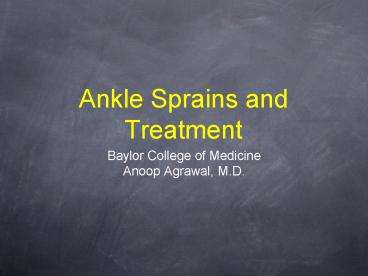Ankle Sprains and Treatment - PowerPoint PPT Presentation
1 / 21
Title:
Ankle Sprains and Treatment
Description:
Ottawa ankle rules Ankle ... Fracture Dislocation or subluxation Syndesmosis injury Tendon rupture Wound penetrating into the joint Uncertain diagnosis ... – PowerPoint PPT presentation
Number of Views:4829
Avg rating:3.0/5.0
Title: Ankle Sprains and Treatment
1
Ankle Sprains and Treatment
- Baylor College of Medicine
- Anoop Agrawal, M.D.
2
Quick Review
- Name the ligaments on the lateral aspect of the
ankle. - ant talofibular (ATFL), calcaneofibular (CFL),
and post talofibular (PTFL)
3
Quick Review
- Name the ligaments on the medial aspect of the
ankle. - deltoid ligament
4
Quick Review
- What is the most common mechanism of injury that
results in an ankle sprain? - inversion with plantarflexion
- What is the name of the guidelines designed to
assess need for radiographs? - Ottawa ankle rules
5
Ankle Sprains
- Classification based on location and grade
- Location
- Lateral
- Medial
- Syndesmostic (high ankle sprain)
6
Lateral Ankle Sprain
- Most common type
- Which ligament is always involved in this type of
sprain? - ant talofibular ligament (ATFL)
- Stronger forces of injury may also involve the
CFL. The CFL rarely is injured in isolation.
7
Medial Ankle Sprain
- Uncommon injury due to the strength of the
deltoid ligament - Forced eversion can damage the deltoid, but more
commonly results in an avulsion fracture of the
medial malleolus because of the deltoids
strength.
8
Syndesmotic Sprain(High Ankle Sprain)
- One more ligament to KNOW...actually two more
- ant and post tibiofibular ligaments (syndesmosis
ligaments) - Occurs with dorsiflexsion and/or eversion, often
times with concomitant lateral force to the knee - What exam maneuver is performed to assess for
this sprain?
Squeeze Test
9
Syndesmotic Sprain
- Anterior tibiofibular ligament
- Posterior tibiofibular not pictured
- Positive Squeeze test on exam
10
(No Transcript)
11
(No Transcript)
12
May see widened space between fibula and tibia.
Normally, less than 5 mm wide.
13
Ankle Sprains Grade
- Three Classifications of Grades
- Grade I partial tear of ligament, no functional
impairment, not frequently seen in the office - Grade II incomplete tear of ligament with mild
to moderate functional impairment, pain with
weight bearing - Grade III complete tear and loss of integrity of
ligament, usually unable to bear weight - Time for healing is not always proportional to
grade.
14
Treatment
- RICE - rest, ice, compression, elevation
- NSAIDS
- Functional Rehabilitation vs. Immobilization - In
grade I and II, all studies have found rehab to
be superior to immobilization in every aspect. - For grade III - controversial, but a few studies
support early functional rehab - Splints and braces - semi-rigid device allowing
for plantar and dorsiflexion with
stabilization/prevention of inversion/eversion
15
Rehab Program
- Functional Rehab begins on the day of the injury.
- There are four progressive phases
- Range of Motion - start immediately
- Achilles Tendon stretch
- Write upper case alphabet with great toe
- Perform each three to five times a day
16
Rehab Program
- Muscle Strengthening - phase two, begin as
swelling and pain are controlled. - Isometric (using walls) and isotonic (using
resistance bands/towels) exercises -
dorsiflexion, plantarflexion, inversion, eversion - Toe curls - two sets of 10, twice a day
- Toe raises - two sets of 10, twice a day
- Emphasis on strengthening peroneal and anterior
tibialis muscles (dorsiflexion, eversion)
17
Achilles Tendon stretch
18
Rehab Program
- Proprioceptive training
- Activity-specific training
- Walk-jog
- Jog-run
19
Orthopedics Referral
- Reasons for referral
- Fracture
- Dislocation or subluxation
- Syndesmosis injury
- Tendon rupture
- Wound penetrating into the joint
- Uncertain diagnosis
- Neurovascular compromise requires emergent care
20
References
- Chorley, J, Powers, C. Clinical Features and
Management of Ankle Pain in the Young Athlete.
Up To Date, 2006 - Maughan, KL. Ankle Sprain. Up To Date, 2006.
- Pfeffer, GB. Foot and Ankle. Essentials of
Musculoskeletal Care, Greene, WB (2nd Ed).
American Academy of Orthopaedic Surgeons,
Rosemont, IL, 2001. - Wolfe, MW, et al. Management of Ankle Sprains.
American Family Physician 631 Jan 1, 2001.
21
Questions?

